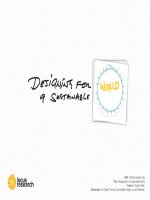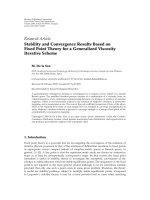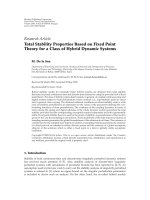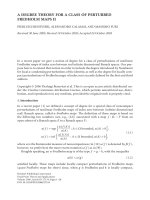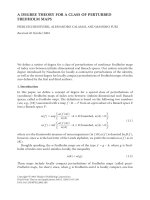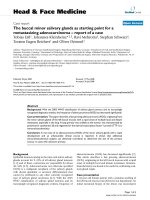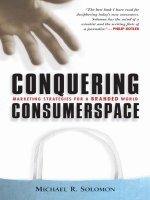ORGANIZATION understanding organization as process theory for a tangled world
Bạn đang xem bản rút gọn của tài liệu. Xem và tải ngay bản đầy đủ của tài liệu tại đây (1001.03 KB, 200 trang )
Understanding Organization
as Process
Organization takes place in a tangled world, intermeshed by changing markets,
products, standards, technologies, institutions and social groups. Coming to grips
with the complexity and fluidity of organization and management is a persistent
problem for scholars and practitioners alike, which is why process studies have
received renewed interest in recent years. This book, aimed at scholars and higher
level students, frames some of these issues in novel and instructive ways.
Process views have existed since before the early Greek philosophers and have
made a decisive mark in all sciences. Alfred North Whitehead’s classic work is
a landmark in process philosophy, and his thinking provides renewed impetus to
social scientists in search of an expanded framework of process thinking. Theorists
such as Niklas Luhmann, Bruno Latour, Karl Weick and James March have contributed significantly towards a process view of organization. In this book, central
aspects of their thinking are interpreted and discussed with the help of a broader
canvas of process thinking provided by Whitehead. From the analysis, ideas are
suggested for a framework for process-based organizational analysis.
Advanced students and academics in sociology, organization studies and
management studies will find this book useful in its discussion of such subjects as
organization theory, process philosophy and process studies.
Tor Hernes is Professor at the Norwegian School of Management, where he is
also Head of the Department for Innovation and Economic Organization.
Routledge Studies in Management, Organisation and Society
This series presents innovative work grounded in new realities, addressing issues
crucial to an understanding of the contemporary world. This is the world of organised societies, where boundaries between formal and informal, public and private,
local and global organizations have been displaced or have vanished, along with
other nineteenth century dichotomies and oppositions. Management, apart from
becoming a specialized profession for a growing number of people, is an everyday
activity for most members of modern societies.
Similarly, at the level of enquiry, culture and technology, and literature and
economics, can no longer be conceived as isolated intellectual fields; conventional
canons and established mainstreams are contested. Management, Organisation
and Society addresses these contemporary dynamics of transformation in a manner
that transcends disciplinary boundaries, with books that will appeal to researchers,
student and practitioners alike.
1
Gender and Entrepreneurship
An ethnographic approach
Attila Bruni, Silvia Gherardi, and Barbara Poggio
2
Understanding Organization as Process
Theory for a tangled world
Tor Hernes
Other titles in this series:
Contrasting Involvements
A study of management accounting practices in Britain and Germany
Thomas Ahrens
Turning Words, Spinning Worlds
Chapters in organizational ethnography
Michael Rosen
Breaking Through the Glass Ceiling
Women, power and leadership in agricultural organizations
Margaret Alston
The Poetic Logic of Administration
Styles and changes of style in the art of organizing
Kaj Sköldberg
Casting the Other
Maintaining gender inequalities in the workplace
Edited by Barbara Czarniawska and Heather Höpfl
Gender, Identity and the Culture of Organizations
Edited by Iiris Aaltio and Albert J. Mills
Text/Work
Representing organization and organizing representation
Edited by Stephen Linstead
The Social Construction of Management
Texts and identities
Nancy Harding
Management Theory
A critical and reflexive reading
Nanette Monin
Understanding Organization
as Process
Theory for a tangled world
Tor Hernes
First published 2008
by Routledge
2 Park Square, Milton Park, Abingdon, Oxon OX14 4RN
Simultaneously published in the USA and Canada
by Routledge
270 Madison Avenue, New York, NY 10016
This edition published in the Taylor & Francis e-Library, 2007.
“To purchase your own copy of this or any of Taylor & Francis or Routledge’s
collection of thousands of eBooks please go to www.eBookstore.tandf.co.uk.”
Routledge is an imprint of the Taylor & Francis Group, an informa
business
© 2008 Tor Hernes
All rights reserved. No part of this book may be reprinted or reproduced or
utilised in any form or by any electronic, mechanical, or other means, now
known or hereafter invented, including photocopying and recording, or in
any information storage or retrieval system, without permission in writing
from the publishers.
British Library Cataloguing in Publication Data
A catalogue record for this book is available from the British Library
Library of Congress Cataloging in Publication Data
Hernes, Tor.
Understanding organization as process: theory for a tangled world/
Tor Hernes.
p. cm. – (Routledge studies in management, organizations and society)
Includes bibliographical references and index.
1. Organization–Philosophy. 2. Organizational sociology. I. Title
HM786.H473 2007
302.3 5–dc22
2007013316
ISBN 0-203-93452-0 Master e-book ISBN
ISBN10: 0-415-43305-3 (hbk)
ISBN10: 0-203-93452-0 (ebk)
ISBN13: 978-0-415-43305-1 (hbk)
ISBN13: 978-0-203-93452-4 (ebk)
To Tania and Maya, with love
Contents
Preface and acknowledgements
Introduction
xiii
xiv
1
1
Organization in a tangled world
Looking for the organization 1
The ‘in-here’ and the ‘out-there’ 2
A correlational view and some problems 7
A relational view 12
A question of locus of selection 16
Becoming in the place of change 17
2
Process views of organization
Early and recent debates 19
The very early thinkers 24
Enter the twentieth century science and philosophy 26
Back to organization studies 28
Entification 30
19
3
Alfred North Whitehead on process
Introduction 32
Ultimate process versus ultimate fact 34
An atomistic view 37
The power of becoming 40
Potentiality and actuality 41
Events 44
Formation of meaning and the changing subject 49
Events and entities 52
Organization between concrete experience and abstraction 53
Extracting foci from Whitehead 55
32
x
Contents
4
Bruno Latour: relativizing the social, and the becoming
of networks
Introduction 59
Experimentation as organization and vice versa 63
Actor-networks and their theory 65
The fallacy of levels of analysis 68
Translation, inscription and stabilization 70
Enrolment – the outward dynamics of networks 73
Connectivity 75
On Latour, Whitehead and organization 76
5
6
7
Niklas Luhmann on autopoiesis and recursiveness in
social systems
Introduction 78
Background and principles 79
Autopoiesis 82
Time and structure 85
Events, contingencies and horizons 87
From meaning to expectations and beyond 88
Complexity, autopoiesis and identity 91
On the absence of the subject 93
On Luhmann, Whitehead and organization 94
James March on decision processes and organization: a logic
of streams
Introduction 96
How organizations become: decisions connecting decisions 99
Signals and symbols 103
The inefficient yet indispensable histories: search processes
and learning 106
The power of routines and the subtleness of change 110
On March, Whitehead and organization 112
Karl Weick on organizing and sensemaking
From entities to process 114
The power of language 116
Verbs: the intersubjective side of processes 118
Nouns: the tentative fixing of patterns 120
Organizing between nouns and verbs 122
The question of extension of timespaces 124
On Weick, Whitehead and organization 125
59
78
96
114
Contents
xi
8
A scheme for process-based organizational analysis
Introduction 128
The primacy of connecting 129
Organization as reiteration and novelty 132
The essence of plot 134
The potentiality-actuality dimension 136
The Grameen Bank: a tangled story 137
128
9
Some implications for organizational analysis
A different way of studying things 142
Understanding rather than measurement 143
Capta rather than data – selection rather than finding 145
Labels and muddles 147
142
Notes
Bibliography
Author index
Subject index
151
155
166
169
Preface and acknowledgements
In a general sense, process thinking observes the journey between immaterial
events and material entities. In one sense, a book is a material entity that enters
libraries, databases and some private bookshelves. On the other hand, a book
represents also the many non-material events on its journey towards completion.
To be sure, some events are rather uneventful in the sense that they are mere occurrences that fit into the overall process; they become part of the process, neither
energizing it in any particular way nor really altering its course. Then there are
events that are more significant, reflecting what Bateson (1972) called ‘the difference that makes the difference’. Such events include, in my case, my reading of
Whitehead’s work, which initially grew out of my interest in Niklas Luhmann’s
autopoietic systems theory. And they include my reading of the works of Bruno
Latour, James March and Karl Weick. Their works represent more than just incisive understandings about the world of people, organization and technology. They
also open the Pandora’s Box of a fluid and complex world while simultaneously
providing frameworks for navigating in this fluid and complex world. In a sense,
they all show the difficulty of coming to grips with this world while at the same
time providing inspiration and boldness to engage with it.
Eventful events also include encounters, and a number of people have been
very influential for this book. I am grateful to Tore Bakken and Elke Weik, with
whom I have shared many ideas in the crossroads between philosophy, sociology
and organization. I also extend my thanks to various scholars with whom I have
worked or been in contact with over the years and who have been sources of
inspiration, including Robert Chia, Barbara Czarniawska, Christina Garsten and
Giovan Francesco Lanzara. Colleagues at the Norwegian School of Management
BI have provided much impetus to the work, especially Thomas Hoholm, Anne
Louise Koefoed, Per Ingvar Olsen, Gerhard Schjelderup and Anne Live Vaagaqsar.
I am grateful to Tore Bakken, Kajsa Lindberg, James March, Mona Solvoll and
Elke Weik for reading and commenting on parts of the manuscript. Thanks also to
the informal Llorg group in the Geneva area for providing stimulating occasions for
discussing process and management. Many thanks to John Cobb and John Quiring
for receiving me at the Center for Process Studies at Claremont, California.
Introduction
All that counts is the facts!
And, of course, intuition!
(Peter Sellers as Inspector Clouseau in the Pink Panther movie)
Organization takes place in what may appropriately be described as a tangled
world, a world where there are discernable elements, but ones which are twisted
together, entwined in ways that add up to an untidy mass. The mass has contours which may have names, but it is a matter of definition as to where and
when one contour stops and another begins. The mass twists and unfolds continuously, which is why practitioners experience it as an unfolding process, a
flow of possibilities, and a conjunction of events and open-ended interactions
occurring in time (Tsoukas and Chia, 2002:572). Still, in this mass, we can
identify and give names to separate strands in the form of processes, such as a
sequence of actions, a set of rules, a collection of narratives or a flow of resources.
We know to a lesser extent, however, how the different strands interact and influence one another. Over time and space, strands mesh with other strands and
produce together something that we may sense the contours of, but not the full
contents. Such a tangled mass may be what we see as an organization, knowing
that it is under continuous modification and reproduction. It is for this reason that
Martha Feldman applies the very appropriate term ‘ongoing accomplishments’ to
organizations.
Tangled processes cannot be undone and their complexity defies analysis.
They become what Latour (1999a) refers to as ‘black boxes’ or what Whitehead
([1929]1978) referred to as ‘complex unities’. Nevertheless, we can follow separate strands for some of their lengths which yields some insight into how they
evolve and connect. Organizing implies attempts at creating a meaningful and
predictable order out of a tangled world. It implies bringing together strands of
a tangled whole according to some coherent model of expectations. Programmes
of actions, for example, may be connected to achieve an innovation or a brand.
As these models enter the mass of a tangled world, they change and produce new
realities in turn. They change the part of the tangled world out there that we are in
Introduction
xv
touch with and, as we learn from how they fare, they change our ways of coping
with the situation in turn.
I have chosen the term ‘tangled’ to illustrate that there is a world that is not
just complex, but one where entities – such as actors, technologies, brands and
rules – emerge and co-evolve. Actors, for example, are made from what they do
to other actors. In other words, they are what they are through the way that they
relate to others. Cooper (2005a) suggests that relating is the continuous work of
connecting and disconnecting in a fluctuating reality. Hence, because the world
around an actor is fluid and eludes attempts at fixation, what an actor ‘is’ at one
instant in time is not the same as what that actor ‘is’ at another instant in time.
Actors may appear more or less stable over the time that we study them, but the
point is not to treat them as fixed entities.
I could well have chosen other words than ‘tangled’, as a number of other
terms come close to what I want to express. Law (2004) mentions a number of
possible words such as ‘slippery’, ‘indistinct’, ‘complex’, ‘elusive’, ‘diffuse’ and
‘messy’. Throughout his book he sticks to the term ‘messy’, taking care to point
out that using such a term, rather than defining a particular way of seeing the
world, is merely a means of remaining open to the idea that, whatever we study,
it is important to assume that it is indefinite, open, complex and unformed.
The reason for my attraction to the word ‘tangled’ is that I find that it conveys an imagery illustrative of how processes may be both distinguishable and
indistinguishable, how they relate more in some ways and less in others. It is
also descriptive of how a shape is temporarily formed while at the same time it is
unformed, because a tangled mass may continuously be on the move to becoming
something else.
Tangled processes may evolve and interact to form various entities including
political parties, brands, services, institutions or products. The time dimension is
important because what we perceive of them at the moment is the result of how
they have developed over time. In a sense they ‘are’ their histories, which makes
it difficult to get access to the processes that shape organizations and institutions.
Their histories are tangled and do not evolve neatly, apart from each other. Consequently they elude the models that we use to understand them, and also the
models we use to create them, because their histories far exceed the models used
to decipher their complexity. The phenomenon of Nike shoes, for example, cannot
simply be reduced to an organization producing shoes. Instead there are multiple
processes that operate to stabilize Nike as an idea that forms part of modern culture, for better or for worse. Would Nike be what it is without the cult of American
basketball? Without the stories of its founders? Without its logo? And would its
logo be the same without the cult of American basketball, without the stories of the
Nike founders? Sure, there might still be Nike, but not Nike as we experience it.
And that is the point. Every organization and institution is a unique product of
circumstances and a unique producer of circumstances in turn.
Nor is the European Union, for example, simply an organization that produces
legislation, rules and projects. The European Union is a project that has evolved
partly in response to two disastrous wars in Europe, perhaps accelerated by the
xvi Introduction
Balkan wars in the 1990s. It is also a project for rationalizing economic and
industrial activity, such as by the introduction of the Euro. And it is constituted by
the idea of a European identity. But wars, economies and identities are not things
in themselves. They constitute processes of becoming in their own right that get
entangled with one another to become something that we recognize temporarily
as the European Union (EU). As to the EU itself, it is and always will be in the
making. We can see it as a project, a set of ideas, around which processes interact
and stabilize – even if only temporarily. Moreover, the idea of the EU influences
things in turn. It becomes entangled with processes of a more global nature such
as disarmament, the problem of terrorism and Third World poverty. As the EU
interacts in other processes, often through the hard work of individuals, it does
remain the same EU. I, for one, would be hard pressed to believe that the EU is the
same today as it was before the events of 9/11. Nor can the EU be the same after
the 2003 invasion of Iraq; nor will it be the same after the (possible) inclusion of
Turkey as a member state.
You might ask if this amounts to simply describing histories of organizing,
whether they relate to seemingly trivial tasks, to institutions, or to organizations.
Or worse – am I slipping into historical determinism, which tells us that if we
were to trace precedents we would be able to explain how events could have been
predicted with some degree of certainty? Was the Second World War a necessary
event that led to the creation of the EU? Yes and no. The EU would not be the
EU as we know it today without the Second World War for two reasons. First,
the Second World War is necessarily one factor that triggered the EU. It is no
coincidence, for example, that an important axis of the EU consists of France and
Germany, two countries that have been at war with each other several times in the
last two centuries and which share a border. Second, even if the composition and
the internal story of the EU had hypothetically been the same without the Second
World War, the EU would still not be the same, simply because its significance
could not be the same without the occurrence of the Second World War.
So, yes, the EU as we perceive it today could not be the same without the Second
World War. Are we therefore back to historical determinism? No, because the EU
is not something that occurred in a vacuum. Over the decades that it has existed, the
EU has shaped the forces that have shaped it. The EU as a process has reproduced
itself through its relations with other processes. In fact, not only has it reproduced
itself, but it has reproduced its relations with other organizations and institutions
which have, in turn, reproduced the identities of these other organizations and
institutions. This is what is meant by a tangled world. When we abandon the
assumption of there being stable entities out there (such as organizations), we
venture into deep water indeed. What have been foundations for analysis become
mere quicksand. Wherever we tread in our analysis there is no fixed point that can
be said to be ‘true’.
Nike and the EU are big actors. They are institutions in their own right, like
many others around the world. But process thinking is not reserved for the analysis
of only the big actors. To organize is a process, whether it is a matter of fixing a
door, writing a letter or restructuring a large corporation. It does not really matter
Introduction
xvii
in terms of analysis whether we fix a door or restructure a corporation. If we delve
for a moment into the microcosmos of organizing, it is possible to see what is
meant by the tangling of processes, even at a seemingly trivial level. To organize
implies the transition from a situation of many opportunities in a complex world to
one where we apply models of organizing to solve a problem. Fixing a door, short
of giving it a kick with our foot or slamming it to put it right, normally involves
the use of tools. To retrieve the tools we depend on some system of placing and
ordering them. In other words, we ‘call up’ our home-made system to fix the door.
The system of placing and ordering our tools has been established some time in the
past. It consists effectively of a process that has been initiated and modified over
time. Or, looking at my own system of ordering my tools, it has frequently broken
down into disorder. But whatever the efficiency of the process, it has evolved
and it connects to another process: that of fixing the door. But fixing the door, as
mentioned above, could be done in numerous other ways, including buying a new
one. I choose to do it this way because of my model of how to go about fixing it.
This model of mine enters a world of many other possibilities. Depending on the
outcome, my model may well change after the encounter with that world. Maybe
I will even change as a person. Perhaps I even change from being a business school
professor to becoming a door repair specialist. Very unlikely, but who knows?
Thinking processually about organization means, as I wish to develop it in this
book, to study the dynamics surrounding the imposition of different models of
organization. Latour (1999a) makes such a point in his study of how soil scientists
work in the Brazilian jungle. He observed how they translated their findings on
the ground into some medium of representation and storage, via a set of intermediaries which represents their understanding of the complex world that they
experienced on the ground. It is not so far-fetched to compare soil science analysis
with organization. To obtain a picture that can be extended over time and space
we need to inscribe what we experience into some kind of medium (or model) that
allows the experience to be conveyed to other actors and allows them to compare
it with other experiences. If groups are going to make any sense in relation to each
other in an organized setting that involves several groups, some form of common
representation is needed. Similarly with soil science, when an area of some size
is to be studied, results from different locations need to be transcribed into some
comparable medium. Whether we see this as tension, reflexivity, recursiveness or
dialectics is open to question. The point is that it is a process of transitions that
may be thrown off course, it may stabilize again or it may emerge in another form
altogether.
Fixing doors and sampling soil may seem highly specific – even odd – examples
in relation to organization and management. However, they illustrate the very
principles of process found in any attempt at organizing and managing. They
show in particular how something perceived as stable, even if only temporarily, may emerge from something that is inherently unstable and where many
possibilities exist for what might follow. I have mentioned that Feldman (2000)
uses appropriately the term ‘ongoing accomplishments’ for organizations to point
out how seemingly stabilized states are the result of painstaking processes with
xviii Introduction
uncertain outcomes. They are ongoing in the sense that they are always in a state
of creation, of emergence, of becoming. They are also accomplishments in the
sense that they are forged by historical processes that could have turned out quite
differently, but that made them just what they are. In other words, what we see as
an organization is one of many possible outcomes, and that is why it is so important to study the processes by which it becomes rather than just the outcomes
(Aldrich, 2001).
To those who seek comfort in numbers or fixed points, this may seem discouraging. They may even reject it as belonging to the world of social science riddled
with social constructivist thinking, laissez-faire logics and ‘anything goes’ attitudes. They may be partly right; but if we go to the other end of the spectrum of
the family of sciences and visit mathematicians, who should, at least in the eyes
of a student of the social world, hold the key to certainty, we may be surprised.
The mathematician George Spencer Brown, whose calculus of form has proved to
be a breakthrough in mathematics, worked precisely from the assumption of indeterminacy, from the assumption that we simply have no firm basis of knowledge,
numbers included. In the preface to the 1994 edition of his book Laws of Form he
states (p. ix): ‘All I teach is the consequences of there being nothing. The perennial mistake of western philosophers has been to suppose, with no justification
whatsoever, that nothing cannot have any consequences’.
Many works on organization and management theory have tried to search for
certainty and stability where there is not much but uncertainty and instability. They
have produced regularity when what seems regular is a mere illusion because the
world is fluid; each situation is unique, even if it looks similar to other situations.
But uniqueness does not mean that we have to reconstruct our theories every time
we study a new situation. We can, with a bit of creativity and modesty, provide
useful and interesting explanations to many situations. We may, as John Law
formulates it, apply a modest kind of sociology that does not assume certainty
but that, to the best of its ability, pursues uncertainty, cautiously untangling an
otherwise tangled world. Law (1994:9) puts it better himself:
And when [sociology] has done better, this has often been because it has
concerned itself with the description of social processes. Such descriptions
simplify, for to tell a story about anything is already to simplify it. But they are
less prone to heroic reductionism than some, for they also tell, or at any rate
they assume, that they are incomplete. And they tell that they are incomplete
not because they haven’t quite finished sorting out the order of things, but
rather because they know that it is necessarily that way: they will always be
incomplete. Such sociologies are relatively modest, relatively aware of the
context of their own production, and the claims that they make are relatively
modest in scope.
Once we recognize that the world is tangled and not limited to isolated, linear and
ordered processes, we recognize by implication that it is infinitely complex, and
moreover, that our ability to understand it really is very small compared with the
Introduction
xix
complexity that surrounds us. This was recognized by Whitehead as a justification
for coming to grips with how anything becomes in a world of so many possibilities.
This is also why modesty, as Law suggests, is so important.
To understand how stability emerges from something essentially unstable
involves understanding how something becomes. Nike, the EU, or ways to fix a
door are not inscribed in the world as natural facts. They evolve as a few possibilities among a large number of other possibilities. In other words, they are examples
from among many other candidates that might have emerged as well, but which did
not. Herein lies an important preoccupation in process studies, namely producing
plausible explanations of how something becomes what it is. Evolutionary theory
would postulate that entities emerge and endure because they perform better than
other entities. If that were true, technological solutions that dominate in the world
would always prove to be better than their competitors. Alas, such a postulate is
hard to maintain as an absolute fact. Studies of technological innovations suggest
that there are factors other than solely performance that make solutions stabilize
and endure. Latour (1987), for example, suggests that the Diesel engine’s popularity has more to do with the ability of stakeholders to commit authorities, other
technologies, communities and others to the innovation than the sheer performance
of the engine itself. According to Latour, there were several other competitors at
the time that were technologically as sophisticated as the Diesel engine. Hence
the explanation of the dominance of the Diesel engine does not lie in superior
technology. Its apparent success does not lie in the characteristics of its substance.
The explanation lies instead in the way that the concept of the engine is related to
other factors. The explanation is relational, not substantial. It becomes what it is
through its various encounters with other technologies, communities and actors.
It has moved from being something unstable, even unlikely, to being a stable and
dominant technology.
To say that the Diesel engine is stable is not really saying anything other than
that it is more stable than other emerging technologies. Perhaps more precisely, it
is perceived as sufficiently stable for it to form part of models with which actors
organize the world around them. Attempts at organizing are rooted in what March
(1981) calls ‘models of the world’. Models are what human actors can operate
with. We cannot fathom the complexity of the world that we engage with so we
‘enact’, to use Weick’s term, a reality based on what makes sense to us. But we do
not escape unchanged from enactment. Experiences change the way that we enact
again in the fluid complex world around us. It is the journeying between the world
and the attempts to model the world that is seen as the process.
Journeying is attempted in this book with the help of process thinking, largely
inspired by the work of Alfred North Whitehead. Process thinking seeks to shed
light on the developmental nature of the world, emphasizing ‘becoming’ rather than
static ‘being’. Rather than studying how entities influence one another, it stresses
the inter-relatedness of entities, how they transform each other. Because entities are
in a perpetual state of change, they can never ‘be’ anything; they change and they
are largely indecipherable. Nevertheless, we can have experiences of the world,
and the experiences also change the world in turn. In the case of organizations,
xx
Introduction
for example, Czarniawska (2004:780) points out that ‘Humans [. . .] construct[ed]
this machine but, once constructed, the machine continues to construct them’.
Whitehead’s work forms a canvas against which the contributions of Weick,
Latour, Luhmann and March are interpreted in this book. The attempt is ambitious
and not without its flaws. Whitehead’s work is a vast philosophical project which,
through process metaphysics, aimed at explaining fundamentals of how the world
evolves. His work spans the realms of the metaphysical and the physical, merely
skirting the social. In this vast project, the question of the social actually gets little
attention. Societies, in Whitehead’s work, are particular phenomena where actual
occasions, or events, display similarities. Social systems are mere subspecies of
what he would term ‘societies’. Whitehead’s work thus took place at a long distance
from social systems such as organizations, although he did bring up the subject
of social systems, business and also that of routines (Whitehead, [1933]1967).1
Routines, according to Whitehead (1911:61) are crucial because they enable us to
rationalize and thus experiment with other things:
It is a profoundly erroneous truism repeated by all copybooks, and by eminent
people when they are making speeches, that we should cultivate the habit of
thinking of what we are doing. The precise opposite is the case. Civilization advances by extending the number of operations which we can perform
without thinking about them. Operations of thought are like cavalry charges
in battle – they are strictly limited in number, they require fresh horses, and
must only be made at decisive moments.
His lack of treatment of the specifics of social systems, however, has not
deterred scholars from drawing inspiration from his work in the study of organization, although attempts are at present few and far between. Probably his
most important contributions in this respect lie in his thoughts concerning consciousness and experience, and in how he thinks about ways in which human
experience comes to be embedded and extended through abstractions. According to
Whitehead, experience comes prior to consciousness; we experience through intuition, whereas cognition and consciousness are derivatives of experience produced
through abstractions (Dibben and Smallman, 2005). Most students of organization
will recognize that organization studies is an ever expanding field of abstractions,
which opens questions about how abstractions emerge, how they are reproduced
and how they become embedded in social discourse.
The potential for organization studies to benefit from Whitehead’s work would
depend on a better understanding of the implications of taking the radical stance
of viewing the world as process. When there is no stable substance and nothing
ever stays the same, we theorize on quicksand rather than from foundations. What
to do when there are no real facts to start with? Whitehead’s response is to study
how anything can become. Everything emerges from a fluid world, and anything
that persists and becomes something is in itself an accomplishment. Conventional
theorists might be dismayed by the existence of disorder; they should instead be
inspired to marvel at the existence of order. And rather than just looking at the
Introduction
xxi
‘big orders’, they should look at how seemingly trivial orders emerge. Maybe
Whitehead ([1929]1978:5) was being ironical when he wrote: ‘It requires a very
unusual mind to undertake the analysis of the obvious’. In any case, applying process thinking to seemingly obvious organizational phenomena can inspire some
new ideas about how things are and how they become. An example is the study of
routines which, if seen as standard solutions, may appear obvious and thus of limited interest for research. However, if routines are seen as connected sets of actions
that may lead to various constellations, including organizations, the phenomenon
of routines takes on a different meaning altogether.
Whitehead’s work does not provide answers, but invites reflection. He offers a
canvas of possibilities, and this canvas is broad enough to enable a useful discussion of the ideas in organization studies. There is already a distinguished history
of process thinking in organization studies, but much process thinking is based
either on evolutionary theory or on the idea of organizations as things, or both.
Weick contributed towards shifting the focus from what an organization or structure is to how it is accomplished. March and colleagues have similarly worked
from a process perspective and have produced insights into flows of decisions
and learning in organizations, but without assuming that the organization is a
context-dependent, circumscribed entity. From outside the field of organization
studies, Luhmann and Latour have extended and deepened process thinking in different directions. Luhmann worked from a broader social systems perspective, and
applied his autopoietic perspective to organizational decision making (Luhmann,
2000). His thinking seems useful for extending understanding about the notions
of time, events and contingencies. Latour has not applied his actor-network theorizing to organizations per se. However, his work on relating the social to the
technological, showing how the two emerge together, holds great promise for
organizational theorizing, especially if organization is perceived as acts of connecting rather than circumscribing, the former being the view put forward in this
book.
This book is an attempt at translating the ideas of these writers into some form of
rapprochement over a process theory of organization. It is an attempt at organizing
a meeting between them, with process on the agenda, chaired by Whitehead. The
attempt may have its flaws; some of them may even be unacceptable to some
readers. It is highly unlikely in particular that I have fathomed the full implications
of Whitehead’s work. Kant commented that it would be a strange coincidence if
the complexity of the world were matched by the human mind’s understanding
of it. Well, it would be equally strange if the complexity of Whitehead’s work
were matched by my understanding of it. In my self-defence, though, this is my
interpretation of the theorists as I try and hold them up against each other, which
is not the same as interpreting them entirely separately. It is based on my selection
from their work.
The theorists on whose works this book is based (Whitehead, March, Weick,
Latour, Luhmann) are all giants in their respective fields. The only way to write
the manuscript was to climb onto their shoulders. Anybody who has tried something similar will probably confirm that climbing onto the shoulders of giants is
xxii Introduction
a dizzying experience. But climbing onto the shoulders of giants is perhaps a bit
like climbing mountains. It would be a shame to give up before getting to the top.
Still, standing on the shoulders of giants is certainly no guarantee that you will be
able to see as far as they do. It provides only possibilities for seeing further. What
you do with them, well, that all depends on you.
Philosophers might find my use of Whitehead’s work too selective, or superficial, or both. His thinking extends way beyond the treatment in this book. The
richness of his texts is related to the aims of his philosophical work, which were
to provide a framework for understanding the world’s evolution. His work builds
on, while also extending beyond, the works of Aristotle, Plato, Lucretius, Locke
and Descartes. Its fundamental aims, located in cosmology, put it at a great distance from social science. As mentioned already, in Whitehead’s work, social
systems have no privileged place; they are a mere sub-species of a more complex
universe. He mentions social societies as but one possible type of society among
many. Societies only become societies when they are able to reproduce themselves;
when ‘they become their own reasons’. When he treads close to the world of organization, notably by bringing up the subject of routines, he seems more interested
in how ants endure, through organization, in the natural world, than in the role of
routines in human society. Notwithstanding, Whitehead’s preoccupation was to
explain how human experience is made durable, which could well be an element
in a generic definition of organization. But here lies perhaps the main usefulness
of Whitehead’s work: his ideas become an exciting reservoir for thinking about
the social and process. For example, his contention that process cannot be ‘just’
physical or ‘just’ mental provides impetus to thinking about the roles of technologies in the unfolding of processes, something that has been pursued for several
years by Latour, Callon, Law and other writers associated with the actor-network
tradition.
The use of Whitehead’s ideas in the present text has been dictated more by
their utility for expanding on the use of process in relation to organization than
by any obligation to explain as much about them as possible. Thus an attempt
has been made to synthesize and siphon off the most succinct insights that appear
useful for illuminating the process side of organization. Most people who have
engaged with Whitehead’s work will confirm that it is not to be read linearly from
A to Z with the intent of summarizing it in clear and unambiguous terms. On the
contrary, his writing is very much alive and full of surprises; I feel that it is like
revisiting an exciting place that never looks quite the same. It gives inspiration
in spurts and helps illuminate questions that I grapple with at the moment, and at
another moment the same sentences may illuminate different questions altogether.
Thus, there is some comfort in reading Latour’s (2005b) description of reading
Whitehead, who likens it to whale-watching on the coast of San Diego in the
winter: ‘You stay on a boat for hours, see nothing, and suddenly “there she blows,
she blows!” and swiftly the whale disappears again’.
In conclusion, this book is a meeting between selected ideas in the works of
Luhmann, Latour, March and Weick, the principal aim being to illustrate how
their works cast light upon a process view of organization. The meeting is chaired
Introduction
xxiii
by Whitehead, but with Whitehead as a somewhat discrete chairman. The chapters
in the book are meant to bring out differences while connecting themes that are of
interest in the study of organizations. To do that, the book is structured as follows:
Chapter 1. Organization in a tangled world
Looking for organizations as entities poses some problems in that it leads us to
ignore processes by which they are formed. A concrete problem of looking for an
organization may be exemplified by the search for the al-Qaeda terrorist network
in the wake of the invasion of Afghanistan, where no ‘organization’ was found,
but rather a phenomenon that corresponds to a number of successive metaphors.
Organization, rather than being an entity, is a process of formation, although it
may be described in terms of metaphors, or models of the world, by which we
organize. The challenge lies in analysing organizations as relational phenomena
rather than as correlation between entities.
Chapter 2. Process views of organization
Process thinking has a long and distinguished history in organizational analysis.
Relatively recent developments, partly fuelled by renewed interest in the works
of process philosophers such as James, Bergson and Whitehead, have led to an
increased focus on the meaning of process in relation to organizational analysis. Recent contributions as well as the early works in philosophy are discussed.
The discussion suggests that process views may be interpreted according to an
understanding of the process of ‘entification’.
Chapter 3. Alfred North Whitehead on process
This chapter looks at central terms and reasoning in Whitehead’s process philosophy. The radical stance of working from a view of the world as process rather than
as substance has important implications for how we go about organizational theorizing. The purpose of the chapter is to show how some of his profound thinking
can form a canvas against which the contributions of Latour, Luhmann, March and
Weick may be discussed. The chapter ends with the following foci extracted from
the review: events and structure, heterogeneity, abstraction and concrete experience, potentiality, stabilization, and connectivity. These foci are brought into the
discussion of the theorists in the chapters that follow.
Chapter 4. Bruno Latour: relativizing the social, and the
becoming of networks
Latour’s use of actor-networks is an intriguing analysis of how large actors
(networks, institutions, products) emerge through relations between smaller actors.
Latour sees networks as processes where relations are shaped and reshaped. His
work is of particular interest because of the way that he bridges the social and the
xxiv Introduction
material worlds, insisting on the ideas of circulation and translation. A key insight
is that actors, when acting upon a material world, are changed by that material
world in turn.
Chapter 5. Niklas Luhmann on autopoiesis and recursiveness
in social systems
Luhmann’s autopoietic framework brings up the importance of how structure and
process interact. Luhmann’s discussion about the role of contingencies in social
systems is particularly helpful; it explains how events and structures interact in
forming a basis for what may happen next, but without determining what will actually happen. Such thinking has important implications, not just for how processes
are understood, but also for how we go about studying processes.
Chapter 6. James March on decision processes and
organization: a logic of streams
James March’s work on learning and decision making has typically concentrated
on how acting and making sense are intertwined processes in organizations, and
particularly how they may be loosely coupled with attempts at organizing. Related
to the loose coupling is the topic of incoherence: how organizations operate in a
world ruled by incoherence, and how organizational design consists of ways of
coping with incoherence.
Chapter 7. Karl Weick on organizing and sensemaking
The chapter discusses how Weick’s work provides insight into organizing processes in tight situations, where behaviour may switch rapidly between stable
models and organizing, on the one hand, and locally emergent actions on the
other. Weick’s use of the term ‘organizing’ (verb) as opposed to ‘organization’
(noun) is discussed in a process perspective, where it is the oscillation between
verb and noun that is of primary interest.
Chapter 8. A scheme for process-based organizational
analysis
This chapter proposes elements in a framework for process-based organizational
research. Organization, instead of being a stable entity, is seen as a process of
connecting entities which may be more or less disparate and initially unrelated.
The scheme put forward in the chapter is based on four basic ideas: first, the idea
of the primacy of organizing as connecting; second, the idea of organization as
reiteration and novelty; third, the idea of the plot or organization; and fourth, the
idea of actuality versus potentiality.



